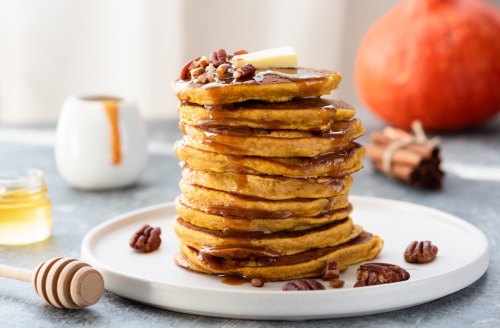The kitchen trick that ensures you’ll always have the materials for buttermilk pancakes
Want to use buttermilk in a recipe but don't feel like buying a whole carton? Here's how to make buttermilk with vinegar at home. (Trust us, it works!)

There are some ingredients that show up in a recipe that used to get it banned from my list—like buttermilk. Often, you’ll need just a quarter or half cup of buttermilk, but the stuff in the store is sold in bigger cartons, meaning I’d inevitably have to throw away the remaining half-gallon I never ended up using once it went bad. Honestly, I was not okay with that. Then I was tuned into the best kitchen hack: making buttermilk with vinegar.
This sounds bizarre, I know. But trust me, it’s the real deal of kitchen shortcuts. The project takes just minutes, but you’ll pat yourself on the back for your resourcefulness. Keep reading for all the details.
First of all…what is buttermilk, exactly?
“Traditionally, buttermilk is the liquid that’s leftover after churning butter,” says Abbie Gelman, MS, RD, CDN, of Culinary Nutrition Cuisine in New York City. Surprisingly, “it’s low in fat and contains most of the protein originally in the milk,” says Gellman. As for why people even use it? “Buttermilk adds tenderness and lightens batter,” says Gellman. It’s a star player in food that could use some fluff (pancakes and biscuits), tang (desserts, smoothies, and dips), or melt-in-your-mouthness (chicken).
Per the USDA, here’s what you get in a cup of low-fat buttermilk:
- Calories: 98
- Fat: 3 g
- Saturated Fat: 2 g
- Protein: 8 g
- Carbohydrate: 12 g
- Fiber: 0 g
- Sugars: 13 g
How to make buttermilk with vinegar at home
So yes, you could just buy buttermilk and use it in your cooking. But if you only need a small amount for a recipe (and don’t want to buy a full carton), Gellman says it’s super easy to DIY. But FYI: The nutrition stats may differ a bit from the above, depending on the milk you use. Here’s how to do it:
1 scant (slightly less than full) cup cow’s milk + 1 tablespoon of distilled white vinegar = homemade buttermilk
That’s it! Stir in the vinegar or lemon juice to your milk and then let the mixture stand for five minutes or so. The acid in the vinegar helps slightly curdle the milk, which makes the texture a bit thicker and adds a tangy flavor similar to regular buttermilk (although a bit milder, says Gellman). Once slightly thickened, you have a buttermilk substitute that you can use exactly as you would regular buttermilk.
What’s the difference between homemade and store-bought buttermilk?
When you buy buttermilk in a carton in the store, it’s made via fermentation. “A bacteria culture is added to low-fat milk and is then heated,” says Gellman. That means that this type of buttermilk contains those good-for-your-gut probiotics like yogurt. If you make it at home, you’re certainly saving money and possible waste, but adding acid like vinegar or lemon juice won’t create probiotics in the mixture. You’ll be left with a liquid that functions in the same way but with a slightly different nutritional profile. That said, if you’re cooking or baking with buttermilk, heating destroys these cultures, and you’re typically using a small amount anyway. (That’s our PSA to say get your probiotics elsewhere.)
If you’re lactose intolerant, you may be in luck. There’s a chance that you may be able to tolerate some buttermilk, as it contains a lower amount of lactose. But if you’ve DIY’d your own buttermilk, keep in mind that it is made with milk, so it will contain the same amount of lactose as before.
How do I use this stuff anyways?
If you’re in need of an intro to buttermilk and want to impress your friends with your culinary prowess, try it in a chicken marinade, like this buttermilk baked chicken recipe from Gellman. Or her amazing pink pancakes made with beet puree and buttermilk.
Another tip: make it your go-to for creamy salad dressings. Gellman recommends combining buttermilk, fresh herbs of your choice (tarragon would be fab), salt and pepper. To make it even thicker and creamier, stir in plain yogurt and add another squirt of lemon juice.
No matter if you choose to DIY or not, I hope the lesson you learn from me is this: there’s no reason to fear buttermilk. Let it push its way into your fridge and sneak into your dishes.
Looking for more smart kitchen tricks? Here’s how to clean that smelly ring inside your Instant Pot lid. And you should probably join our online food community, Cook With Us, for even more kitchen know-how.
Sign Up for Our Daily Newsletter
Get all the latest in wellness, trends, food, fitness, beauty, and more delivered right to your inbox.
Got it, you've been added to our email list.










